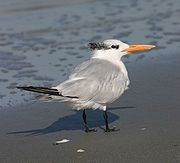
Royal Tern
Encyclopedia
The Royal Tern is a seabird
in the tern
family Sternidae. This bird has two distinctive subspecies. T. m. maximus breeds on the Atlantic
and Pacific coasts of the southern USA and Mexico
into the Caribbean
. The slightly smaller T. m. albididorsalis breeds in coastal west Africa
. The Royal Tern is one of the species to which the Agreement on the Conservation of African-Eurasian Migratory Waterbirds (AEWA
) applies.
but is unlikely to be confused with the carrot-billed giant, which has extensive dark underwing patches. The Royal Tern has an orange-red bill, pale grey upperparts and white underparts. Its legs are black. In winter, the black cap becomes patchy. Juvenile Royal Terns are similar to nonbreeding adults. Differences include juveniles having black sploched wings and a yellower bill.
The calls of the Royal Tern are usually short, clear shrills. SOme of the shrills sound likekree or tsirr; the Royal Tern also has a more ploverlike wistle that is longer, rolling and is more melodious.
 In various parts of its range, the Royal Tern could be confused with Elegant Tern
In various parts of its range, the Royal Tern could be confused with Elegant Tern
, Lesser Crested Tern
(the other orange-billed tern
s), and the Great Crested Tern. It is paler above than Lesser Crested Tern and the yellow-billed Great Crested Tern. Elegant Tern has a longer more curved bill and shows more white on the forehead in winter.
and Argentina
for the winter to escape the cold weather. African breeders move both north and south from the breeding colonies. African birds may reach as far north as Spain
. This species has also wandered to western Europe as a rare vagrant, these records probably being from the American colonies.
The appearance of apparent Elegant Terns in European waters means that records of Royal and Elegant Terns will need to be re-evaluated, since the latter species was thought an improbable migrant to the area.
The Roal tern feeds by diving into the water from heights near 30 feet. The Royal Tern is an opportunist that feeds when it finds schools of fish or small crustaceans.
Like all white terns, it is fiercely defensive of its nest and young. The Royal Tern and the Cayenne Tern nest and breed together in Argentina and Brazil.
Tern nesting sites can also be efected by the tides; if a tern colony has nested to close to the the high tide mark a spring tide would flood the nesting site and kill the chicks and make unhatched eggs infertile.
Seabird
Seabirds are birds that have adapted to life within the marine environment. While seabirds vary greatly in lifestyle, behaviour and physiology, they often exhibit striking convergent evolution, as the same environmental problems and feeding niches have resulted in similar adaptations...
in the tern
Tern
Terns are seabirds in the family Sternidae, previously considered a subfamily of the gull family Laridae . They form a lineage with the gulls and skimmers which in turn is related to skuas and auks...
family Sternidae. This bird has two distinctive subspecies. T. m. maximus breeds on the Atlantic
Atlantic Ocean
The Atlantic Ocean is the second-largest of the world's oceanic divisions. With a total area of about , it covers approximately 20% of the Earth's surface and about 26% of its water surface area...
and Pacific coasts of the southern USA and Mexico
Mexico
The United Mexican States , commonly known as Mexico , is a federal constitutional republic in North America. It is bordered on the north by the United States; on the south and west by the Pacific Ocean; on the southeast by Guatemala, Belize, and the Caribbean Sea; and on the east by the Gulf of...
into the Caribbean
Caribbean
The Caribbean is a crescent-shaped group of islands more than 2,000 miles long separating the Gulf of Mexico and the Caribbean Sea, to the west and south, from the Atlantic Ocean, to the east and north...
. The slightly smaller T. m. albididorsalis breeds in coastal west Africa
Africa
Africa is the world's second largest and second most populous continent, after Asia. At about 30.2 million km² including adjacent islands, it covers 6% of the Earth's total surface area and 20.4% of the total land area...
. The Royal Tern is one of the species to which the Agreement on the Conservation of African-Eurasian Migratory Waterbirds (AEWA
AEWA
The Agreement on the Conservation of African-Eurasian Migratory Waterbirds is the largest of its kind developed so far under the Bonn Convention. It was concluded on 16 June 1995 at The Hague, the Netherlands and entered into force on 1 November 1999 after the required number of at least fourteen...
) applies.
Description
This is a large tern, second only to Caspian TernCaspian Tern
The Caspian Tern is a species of tern, with a subcosmopolitan but scattered distribution. Despite its extensive range, it is monotypic of its genus, and has no subspecies accepted either...
but is unlikely to be confused with the carrot-billed giant, which has extensive dark underwing patches. The Royal Tern has an orange-red bill, pale grey upperparts and white underparts. Its legs are black. In winter, the black cap becomes patchy. Juvenile Royal Terns are similar to nonbreeding adults. Differences include juveniles having black sploched wings and a yellower bill.
The calls of the Royal Tern are usually short, clear shrills. SOme of the shrills sound likekree or tsirr; the Royal Tern also has a more ploverlike wistle that is longer, rolling and is more melodious.

Elegant Tern
The Elegant Tern is a seabird of the tern family Sternidae. It breeds on the Pacific coasts of the southern USA and Mexico and winters south to Peru, Ecuador and Chile....
, Lesser Crested Tern
Lesser Crested Tern
The Lesser Crested Tern is a seabird of the tern family Sternidae...
(the other orange-billed tern
Orange-billed tern
Orange-billed tern is a name applied to a group of three large terns in the genus Thalasseus with orange bills, which are quite similar in appearance and often considered difficult to identify, namely:* Royal Tern, Thalasseus maximus...
s), and the Great Crested Tern. It is paler above than Lesser Crested Tern and the yellow-billed Great Crested Tern. Elegant Tern has a longer more curved bill and shows more white on the forehead in winter.
Habitat and Range
American birds migrate south to PeruPeru
Peru , officially the Republic of Peru , is a country in western South America. It is bordered on the north by Ecuador and Colombia, on the east by Brazil, on the southeast by Bolivia, on the south by Chile, and on the west by the Pacific Ocean....
and Argentina
Argentina
Argentina , officially the Argentine Republic , is the second largest country in South America by land area, after Brazil. It is constituted as a federation of 23 provinces and an autonomous city, Buenos Aires...
for the winter to escape the cold weather. African breeders move both north and south from the breeding colonies. African birds may reach as far north as Spain
Spain
Spain , officially the Kingdom of Spain languages]] under the European Charter for Regional or Minority Languages. In each of these, Spain's official name is as follows:;;;;;;), is a country and member state of the European Union located in southwestern Europe on the Iberian Peninsula...
. This species has also wandered to western Europe as a rare vagrant, these records probably being from the American colonies.
The appearance of apparent Elegant Terns in European waters means that records of Royal and Elegant Terns will need to be re-evaluated, since the latter species was thought an improbable migrant to the area.
Diet
The Royal tern feeds usually feeds on small fish like anchovies, weakfish, silversides, and croakers. Fish are the main ource of food for the Royal Tern but they also been found eating insects and shrimps.The Roal tern feeds by diving into the water from heights near 30 feet. The Royal Tern is an opportunist that feeds when it finds schools of fish or small crustaceans.
Reproduction
The Royal tern Nests on the beaches of islands or on isolated beaches with limited predators. It lays one or two eggs, usually in a scrape, an area on the ground where a tern has made a small hole to lay its eggs, but in some cases tern eggs have been found laid strait onto the ground, not in a scrape. The eggs will incubate from 25 to 30 days, after the eggs hatch the chicks will remain in the scrape for about a week. About two weeks after the eggs hatch the chicks will gather into groups called a crèche. When the chicks are in the crèche they are primarily fed by their parents who may recognize their offspring by their voice and looks. While the chicks are in the crèche they usually roam around the colony freely. When the chicks are a month old they fledge or, start to fly. Royal Terns mature around the 4, after which they begin to build their own nests.Like all white terns, it is fiercely defensive of its nest and young. The Royal Tern and the Cayenne Tern nest and breed together in Argentina and Brazil.
Threats
The Royal Tern has few predators when it is mature, but before the chicks hatch or while they are chicks the tern is threatened by humans, other animals, and the tides. Humans threaten terns by fishing and by disrupting the tern nesting sites. Fishing nets can catch a tern while it is diving, making it unable to feed or it may cause it to drown if it is caught under water. Animals such as foxes, raccoon, and large gulls prey on tern chicks and tern eggs.Tern nesting sites can also be efected by the tides; if a tern colony has nested to close to the the high tide mark a spring tide would flood the nesting site and kill the chicks and make unhatched eggs infertile.
External links
- Royal Tern Photographs South Dakota Birds and Birding

